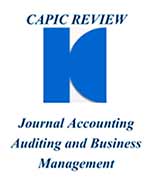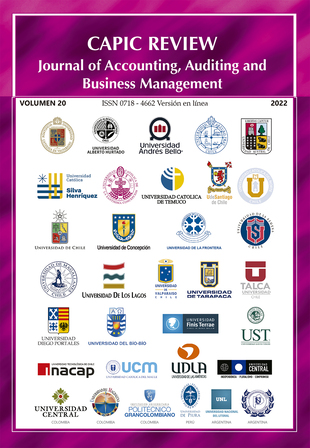Publicado 2022-06-09
Palabras clave
- Innovación,
- Marco de las palancas de control,
- Sistemas de Control de Gestión,
- Sustentabilidad
Cómo citar
Derechos de autor 2022 Sandra del Camen Canale, Julia Cristóbal

Esta obra está bajo una licencia internacional Creative Commons Atribución-NoComercial-CompartirIgual 4.0.
Resumen
El trabajo que se presenta se enmarca en un proyecto de investigación cuyo objetivo es identificar los sistemas de control de gestión (SCG) utilizados por empresas del área de la economía del conocimiento, con el propósito de indagar el uso que los directivos realizan de los mismos para promover estrategias de innovación y a la vez, gestionar organizaciones sustentables. La literatura sobre los SCG ha demostrado que juegan un papel importante en las organizaciones y tienen efectos positivos sobre el rendimiento a través de la información y retroalimentación que generan. Tan trascendental como su diseño es el estilo de uso que realizan de ellos los actores organizacionales. En este ensayo en primer lugar se aborda el análisis de los marcos teóricos predominantes para estudiar los usos de los SCG: por un lado, la tipología de Adler y Borys y por otro el marco de las palancas de control (LOC) de Simons. En segunda instancia se selecciona el marco LOC fundamentado en que sus bases se asientan en los niveles gerenciales y las decisiones estratégicas, que es lo que se pretende estudiar. A su vez, se relevaron investigaciones que dan cuenta del uso de este marco como motor de la innovación, un factor clave para las organizaciones que se pretende estudiar y estudios que apoyan los aportes de Simons para la gestión sustentable.
Descargas
Citas
- Abernethy, M. A. y Stoelwinder, J. U. (1991). Budget use, task uncertainty, system goal orientation and subunit performance: a test of the fit hypothesis in not-for-profit hospitals. Accounting, Organizations and Society, 16, 105–119
- Adler, P. S. y Borys, B. (1996). Two types of bureaucracy: Enabling and coercive. Administrative Sciences Quarterly, 41(1), 61–89.
- Agyemang, G. y Broadbent, J. (2015). Management control systems and research management in universities: An empirical and conceptual exploration. Accounting, Auditing & Accountability Journal, 28(7), 1018–1046.
- Amabile, T. M. (1998). How to kill creativity. Harvard Business Review, Sept–Oct, 76–87.
- Anthony, R. N. (1965). Planning and control systems: a framework for analysis. Graduate School of Business Administration. Harvard University. Boston, MA.
- Arjaliès, D. y Mundy, J. (2013). The use of management control systems to manage CSR strategy: A levers of control perspective. Management Accounting Research, 24, 284-300.
- Bedford, D. S. (2015). Management control systems across different modes of innovation: Implications for firm performance. Management Accounting Research, 28, 12-30.
- Bedford, D. S. (2020). Conceptual and empirical issues in understanding management control combinations. Accounting, Organizations and Society, 86, 1-8.
- Bisbe, J. (2006). El uso de los sistemas de control de gestión por la alta dirección, ¿bloquea o estimula la innovación? Revista de Contabilidad y Dirección, Vol. 3, 177-194.
- Bisbe, J. y Malagueño, R. (2009). The Choice of Interactive Control Systems under Different Innovation Management Modes. European Accounting Review, Vol. 18 (2), 371–405.
- Bisbe, J. y Otley D. (2004). The effects of the interactive use of management control systems on product innovation. Accounting, Organizations and Society, 29, 709–737.
- Bisbe, J., Kruis, AM. y Madini, P. (2019). Coercive, enabling, diagnostic, and interactive control: Untangling the threads of their connections. Journal of Accounting Literature, 42, 124-144.
- Chenhall, R.H. (2003). Management control systems design within its organizational context: findings from contingency-based research and directions for the future. Accounting, Organizations and Society, 28, 127-168.
- Chenhall, R.H. y Morris, D. (1986). The impact of Structure, Environment, and Interdependence on the Perceived Usefulness of Management Accounting Systems. The Accounting Review, 61, 16-35
- Damanpour, F. (1991). Organizational innovation: a meta-analysis of effects of determinants and moderators. Academy of Management Journal, 34, 555–590.
- Dana, L., Mahdi Rounaghi, M. y Enayati, G. (2020). Increasing productivity and sustainability of corporate performance by using management control systems and intellectual capital accounting approach. Green Finance, 3(1), 1–14.
- Dumay, J. y Guthrie, J. (2019). Reflections on interdisciplinary critical intellectual capital accounting research. Multidisciplinary propositions for a new future. Accounting, Auditing & Accountability Journal, 32 (8), 2282-2306.
- Fernandes Crespo, N., Rodrigues, R., Samagaio, A. y Miranda Silva, G. (2019). The adoption of management control systems by start-ups: Internal factors and context as determinants. Journal of Business Research, 101. 875–884
- Ferreira, A. y Otley, D. (2009). The design and use of performance management systems: An extended framework for analisis. Management Accounting Research, 20, 263–282.
- Flamholtz, E. G., Das, T. K. y Tsui, A. S. (1985). Toward an integrative framework of organizational control. Accounting, Organizations and Society, 10(1), 35–50.
- Guthrie, J., Petty, R. y Johanson, U. (2001). Sunrise in the knowledge economy. Managing, measuring and reporting intellectual capital. Accounting, Auditing & Accountability Journal, 14 (4), 365-382.
- Laguir, L., Laguir, I. y Tchemeni, E. (2019). Implementing CSR activities through management control systems: A formal and informal control perspective. Accounting, Auditing & Accountability Journal, 32 (2), 531-555.
- Langfield-Smith, K. (1997). Management control systems and strategy: a critical review. Accounting, Organizations and Society. 22 (2), 207-232.
- Lill, P., Wald, A., & Munck, J. C. (2021). In the field of tension between creativity and efficiency: a systematic literature review of management control systems for innovation activities. European Journal of Innovation Management, Vol. 24 (3), 919-950.
- Martyn, P., Sweeney, B. y Curtis, E. (2016). Strategy and control: 25 years of empirical use of Simons’ Levers of Control framework. Journal of Accounting and Organizational Change, 12 (3), 281-324.
- Miles, R. E. y Snow, C. C. (1978). Organizational strategy, structure and process. New York: McGraw-Hill.
- Otley, D. (1999). Performance management: A framework for management control systems research. Management Accounting Research, 10(4), 363–382.
- Ouchi, W. G. (1977). The relationship between organizational structure and organizational control. Administrative Science Quarterly, 22, 95–113
- Barros, R.S. and Ferreira, A.M.D.S.d.C. (2021), "Management Control Systems and Innovation: a levers of control analysis in an innovative company", Journal of Accounting & Organizational Change, Vol. ahead-of-print No. ahead-of-print. https://doi.org/10.1108/JAOC-09-2020-0137
- Simons, R. (1994). How new top managers use control systems as levers of strategic renewal. Strategic Management Journal, 15 (3), 169-189.
- Simons, R. (1995). Levers of control. Boston: Harvard Business School Press.
- Simons, R. (1995a). Levers of control: How managers use innovative control systems to drive strategic renewal. Boston: Harvard Business School Press.
- Ter Bogt, H. J. y Scapens, R. W. (2012). Performance management in universities: Effects of the transition to more quantitative measurement systems. European Accounting Review, 21(3), 451–497.
- Wijethilake, C., Munir, R. y Appuhami, R. (2017). Strategic responses to institutional pressures for sustainability: The role of management control systems. Accounting, Auditing & Accountability Journal, 30 (8), 1677-1710.



































